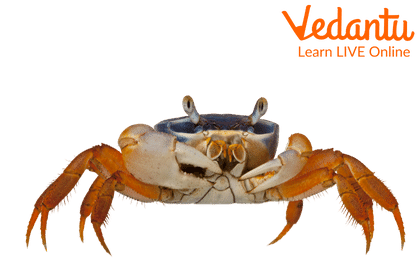




Introduction
Crabs are decapod crustaceans with a very short tail and a thick shell, or exoskeleton, armed with a single pair of claws. There are over 6,793 crab species found in the oceans, in freshwater, and even on land. Brachyura is the scientific name for crab.

Crab
Crab Characteristics:
Crabs have a thick exoskeleton made mostly of highly mineralized chitin and are armed with chelae (claws). Crabs range from a few millimeters wide for the pea crab to a leg span of up to 4 meters for the Japanese spider crab (13 ft). Crabs are omnivorous, eating algae, molluscs, worms, and other crustaceans for meat.
Interesting Facts About Crabs
There are over 6,700 crab species.
The Japanese spider crab is the largest worldwide, measuring 12 to 13 feet.
Pea crabs, which grow to be. Four to.6 inches in diameter are among the world's smallest crabs.
A cast is a collection of crabs.
Crab meat is high in vitamin B12, with 2-3 ounces meeting an adult's daily B12 requirements.
False crabs include hermit crabs, king crabs, and horseshoe crabs.
False crabs are classified as Anomura, whereas other crabs are classified as Brachyura. Anomura has elongated abdomens, tails like shrimp or lobsters, and a smaller last set of legs that are sometimes not visible.
Facts About Crabs
Crabs can walk in any direction but prefer to walk and run sideways.
Crabs are decapods, which means they have ten legs.
Female crabs can lay between 1000 and 2000 eggs at once.
A small crab has an average lifespan of 3-4 years, but larger species, such as the giant Japanese spider crab, can live for up to 100 years.
Soft Shell crabs have molted crabs, so any crab can be a soft shell crab. Soft Shell crabs are commonly known as blue crabs in the United States.
Conclusion
Crab meat is high in vitamin B12, with 2-3 ounces meeting an adult's daily B12 requirements.The swimming legs of the crab are used to produce lump and jumbo lump crab meat. Crab nutrition facts are that dark meat from the crab's body is high in Omega-3.
Solved Questions
1. How many eyes do crabs have?
A) 2
B) 4
C) 6
D) 10
Ans: 10
2. Do crabs have a nose?
Yes
No
Ans: B) No
3. What color is crab blood?
Red
Pink
Blue
Orange
Ans: C) Blue
FAQs on Facts About Crab
1. Crabs, do they have teeth?
Crabs and lobsters have teeth in their tummies. These are used for crushing its food, but they also serve an unusual secondary purpose in ghost crabs: they make a noise that scares away predators.
2. Crabs, do they have hearts?
Crabs are heartless creatures. They have a free circulation system. Vessels in this system pump the animal's blood into sinuses or cavities (holes) in the body.
3. Crabs, do they sleep?
Because the majority of crabs are nocturnal, they sleep during the day. Land crabs sleep on land, while marine crabs sleep underwater. They sleep for the same reason we do: to conserve energy and regenerate!
4. Can crabs cause harm to humans?
Because crabs lack a mechanism for delivering these toxins, such as a bite or poisonous spines, poisoning occurs only when people consume the crabs. Saxitoxin and tetrodotoxin, two of the most lethal natural substances known, can accumulate in the muscles and egg masses of these xanthid crabs.
5. Do crabs have emotions?
York University researchers contend that octopuses, crabs, lobsters, crayfish, and other invertebrates are sentient and can feel pain, anger, fear, and happiness.









